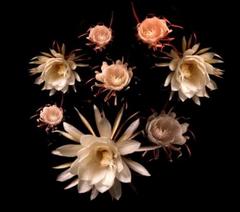By Doug MacCash, via nola.com

Egan's "Spinning Trumpet Flower with Bee" stop-action video sculpture is mesmerizing. Courtesy Heriard-Cimino Gallery
A beautiful yellow trumpet flower was pirouetting like a tiny ballerina on the wall of Courtney Egan’s studio at Louisiana ArtWorks. Beneath it, a bee buzzed around the cone of petals, blurred by motion. Drops of a bright lemon-colored liquid seemed to fall from the flower, landing with a splat, splat, splat sound on the pedestal below.
In the dimly lit studio, where Egan was preparing for an exhibit of her works titled “Field Studies” at Heriard-Cimino Gallery, the spinning flower seemed almost real, as if you could reach out and touch it. But it was actually an example of what Egan, one of New Orleans’ premier video artists, described as her “pretty trickery.” The trumpet flower, bee and yellow droplets were all the product of sly video projection.
The spinning flower seemed three-dimensional because it was projected onto a small blossom-shaped curtain hung from the wall. An unseen speaker produced the sound of droplets hitting a hard surface.
Egan, who teaches media arts at the New Orleans Center for the Creative Arts, has been performing video magic for almost 20 years. At one time, she was known for her Frankenstein-inspired video collages of mixed and matched human body parts. But after Hurricane Katrina, she found herself drawn more and more to subjects from nature. Her current body of work is a series of what you could call traditional botanical still lifes, except, of course, they aren’t still.
And they aren’t presented in the traditional rectangular shape. Like other contemporary video artists, Egan is doing her best to break away from the familiar four-right-angles television format.

Courtney Egan, one of New Orleans' premier high-tech artists. Doug MacCash / The Times-Picayune
Egan’s works bridge the gap between motion pictures and sculpture. Her gently swirling mandala of zinnia blossoms will be projected onto a wax-coated disk hung inches from the gallery wall. Her array of night-blooming cereus flowers eerily open and close like sea anemones on a grid of overlapping video screens. Her magnolia blossoms drift in a beam of light cast directly onto the floor, as if they were koi in a pond. And a miniature video projector not much bigger than a cell phone projects a ghostly strand of Spanish moss onto a twisted strip of sheer window screen.
Egan says she’s fascinated by television wildlife programs, although they may not be exactly as they seem. She says that such documentaries serve up what appears to be a slice of pure natural experience, but they are actually the product of myriad high-tech camera techniques and painstaking video editing. Her own works are “hybrids” of biology and electronics as well, she said.
The stop-action flower videos aren’t made in a fragrant garden; they’re made on a computer scanner. The slowly turning tangle of Spanish moss wasn’t captured on some breezy bayou; it was photographed in the corner of Egan’s Howard Avenue studio. Just to remind viewers of the electronic deceptions going on, Egan sometimes deliberately interrupts her still lifes with a little visual static.
Egan says she hopes her unnaturally natural video sculptures touch on the sublime. Based on my preview, her hopes have been realized.
Video is the dominant art medium of the moment; it’s also among the least tangible. Egan said it troubles her sometimes that unlike conventional painters and sculptors, she has very little physical art to show for her efforts. Most of her work boils down to nothing more than digital information stored on computer disks and hard drives.
There’s a touch of unintentional poetry in that. One of the purposes of the antique still life paintings you see on museum walls is to serve as a reminder of nature’s bounty from season to season. Simply hang them on a wall and old-fashioned oil-on-canvas still lifes can last for hundreds of years. The long-term maintenance of electronic media is much more complicated. No one’s sure if today’s high-tech art will be around hundreds of years in the future. With one of the world’s worst ecological disasters taking place off of Louisiana’s coast, it may be symbolically fitting that the long-term survival of Egan’s modern-day nature-inspired still lifes is uncertain.

The blossoms in Egan's "Night Blooming Cereus Wreath," which will be displayed on a cluster of overlapping screens, open and close eerily. Courtesy Heriard-Cimino Gallery
